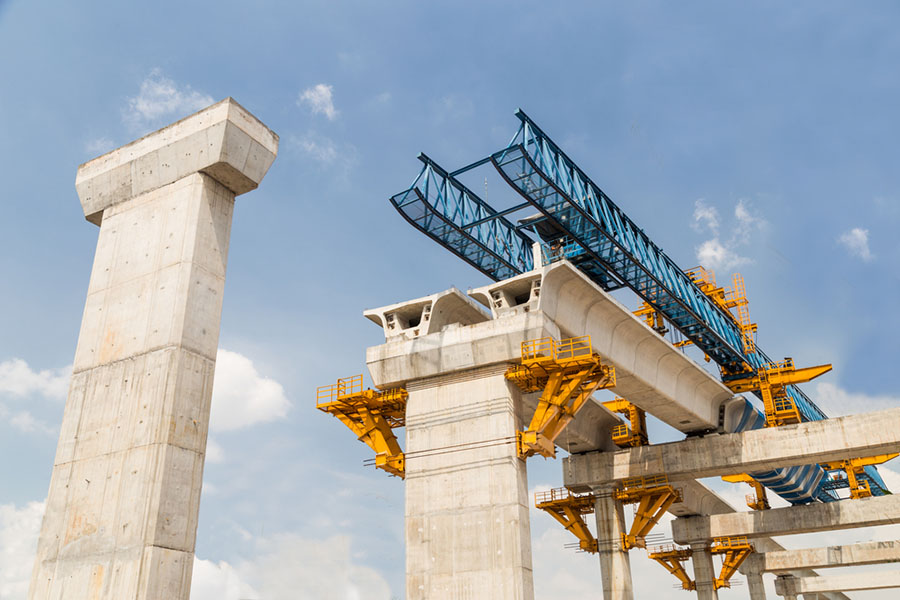Structural engineering, a critical branch of civil engineering, forms the foundation of our built environment. It’s the discipline of designing and analyzing structures to withstand natural forces and human use.
From skyscrapers to bridges, structural engineers ensure the safety and stability of the structures we rely on daily. These professionals work behind the scenes, transforming architectural concepts into reality while adhering to strict safety standards.
Their expertise is crucial in selecting appropriate materials, calculating load-bearing capacities, and solving complex structural challenges. Without them, our cities would lack iconic landmarks and essential infrastructure.
In an era of environmental concerns and rapid urbanization, structural engineers play an increasingly vital role. They pioneer sustainable building practices, innovate with new materials, and create resilient structures capable of withstanding natural disasters.
As construction continues to evolve, structural engineers remain the guardians of safety and efficiency in our built world, ensuring that our structures stand strong for generations to come.

Roles and Responsibilities of Structural Engineers
Designing resilient structures
Structural engineers are the masterminds behind safe and durable buildings. They design structures to withstand various loads and forces, including dead loads from the building’s own weight and live loads from occupants and furniture.
They also account for environmental forces like wind, snow, and earthquakes. Their calculations safeguard the stability of buildings under all conditions.
Regulatory compliance
Adherence to building codes is vital in structural engineering. Engineers must stay updated on local, state, and national regulations. They ensure that every aspect of their design meets or exceeds these standards. This compliance is vital for public safety and legal construction practices.
Collaborative efforts
Structural engineers don’t work in isolation. They collaborate closely with architects to bring design visions to life. They also work with construction teams to guarantee proper implementation of their designs. This teamwork is essential for successful project completion.
On-site expertise
Regular site inspections are a key responsibility. Engineers assess construction progress and ensure adherence to design specifications. They identify potential issues early and provide timely solutions. Their presence on-site is crucial for quality control.
Problem-solving
When structural issues arise, these engineers step in with solutions. They analyze problems and develop effective remedies. This might involve reinforcing existing structures or redesigning elements for better performance. Their problem-solving skills are vital in maintaining the integrity of buildings throughout their lifespan.
Common Projects for Structural Engineers
Residential buildings
Structural engineers play an essential role in the construction of homes and apartment buildings. They ensure that these structures can withstand everyday use and environmental forces. Their work involves designing load-bearing walls, roof trusses, and foundations.
For multi-story residences, engineers focus on creating efficient vertical support systems. They also address unique challenges like cantilevered balconies or large open spaces. Their expertise ensures that residential buildings are safe, comfortable, and long-lasting.
Commercial buildings
In commercial projects, structural engineers tackle complex designs for office buildings, shopping centers, and industrial facilities. They work on creating large open spaces for retail or office use while maintaining structural integrity. Their designs must accommodate heavy equipment, high occupancy loads, and specialized requirements.
These engineers also focus on creating flexible spaces that can adapt to changing business needs. They incorporate innovative materials and techniques to enhance energy efficiency and sustainability. Their work is critical in developing structures that are both functional and aesthetically pleasing.
Bridges and infrastructure
Bridge design is a specialized field where structural engineers shine. They create structures that span great distances while withstanding immense loads and environmental stresses. Their work includes designing support systems, calculating load distributions, and ensuring long-term durability.
Beyond bridges, engineers work on various infrastructure projects like tunnels, dams, and water treatment facilities. These projects often involve unique challenges and require innovative solutions. Engineers must consider factors like soil conditions, water pressure, and seismic activity in their designs.

Retaining walls and foundations
Structural engineers are essential in designing retaining walls that hold back soil or water. They calculate the forces exerted by earth and groundwater to create stable structures. Their designs prevent soil erosion and protect buildings from potential landslides.
Foundation design is another critical area. Engineers analyze soil conditions and building loads to create appropriate foundation systems. This might include deep foundations for skyscrapers or special designs for buildings in areas with poor soil quality. Their work ensures the long-term stability of structures.
Retrofitting and renovations
Modernizing existing buildings is a growing field for structural engineers. They assess older structures and design upgrades to meet current safety standards and building codes. This often involves strengthening load-bearing elements or improving seismic resistance.
In historical preservation projects, engineers find ways to reinforce structures while maintaining their original character. They might use advanced materials or innovative techniques to provide invisible support. Their work breathes new life into old buildings, ensuring they remain safe and functional for years to come.
Choosing a Structural Engineer
Factors to consider
Licensing and certification
When selecting a structural engineer, verify their professional licensing. This ensures they meet minimum competency standards. Look for additional certifications that demonstrate specialized expertise. These credentials indicate a commitment to ongoing professional development.
Experience and expertise
Consider the engineer’s track record with projects similar to yours. Experienced engineers bring valuable insights from past challenges. They should be able to provide examples of relevant work. Ask about their specific expertise in areas integral to your project.
Response time and availability
Assess the engineer’s responsiveness during initial communications. This often reflects their overall work ethic. Discuss their current workload and ability to meet your project timeline. Ensure they can dedicate sufficient time and attention to your needs.
Reviews and testimonials
Research client feedback and professional reputation. Online reviews can offer insights into an engineer’s reliability and quality of work. Ask for references from past clients with similar projects. Direct testimonials provide valuable first-hand accounts of working with the engineer.
Insurance coverage
Confirm that the engineer carries appropriate professional liability insurance. This protects you in case of errors or omissions in their work. Adequate insurance coverage demonstrates professionalism and financial responsibility.
Technology and equipment
Inquire about the tools and software the engineer uses. Modern technology can enhance accuracy and efficiency in structural analysis. Advanced equipment may lead to more innovative and cost-effective solutions for your project.
Questions to ask potential engineers
Prepare a list of questions to assess each candidate thoroughly. Ask about their approach to problem-solving and communication style. Inquire how they handle unexpected challenges or changes in project scope. Discuss their fee structure and what services are included.
Consider asking about their collaboration process with other professionals. Understanding how they work with architects, contractors, and local authorities is crucial. Request examples of how they’ve optimized designs for cost-efficiency in past projects.

Process of Structural Engineering
Initial consultation and assessment
The journey begins with a meeting of minds. Your structural engineer dives into your vision, listening intently to your ideas and concerns. They’ll walk through your site, keen eyes scanning for potential challenges and opportunities. This isn’t just about gathering facts; it’s about building a partnership that will shape your project’s future.
During this phase, your engineer transforms into a detective, uncovering hidden site conditions and local building regulations. They’re laying the groundwork for a design that’s not just sound but perfectly tailored to your needs and the site’s unique characteristics.
Design and planning
Now, creativity takes center stage. Armed with insights from the initial assessment, your engineer sketches out possibilities, breathing life into your ideas. They’re not just drawing lines; they’re crafting a structural story that balances form and function.
This phase is a collaborative dance between vision and practicality. Your engineer will present options, explaining the pros and cons of each approach. Together, you’ll refine the design, ensuring it meets your goals while adhering to safety standards and budget constraints.
Structural analysis and calculations
Here’s where science meets art. Your engineer dons their metaphorical lab coat, diving deep into complex calculations. They’re not just crunching numbers; they’re predicting how your structure will behave under various conditions, from everyday use to extreme events.
Using advanced software and time-tested principles, they’ll analyze every beam, column, and connection. This meticulous process ensures your structure isn’t just stable, but optimized for efficiency and longevity. It’s like giving your building a virtual stress test before a single brick is laid.
Preparing construction documents
With the design finalized and calculations complete, it’s time to create the project’s blueprint. Your engineer transforms complex ideas into clear, detailed drawings and specifications. These documents are the bridge between concept and reality, guiding the construction team through every step of the build.
More than just pretty pictures, these documents are packed with crucial information. They detail material specifications, connection methods, and construction sequences. Think of them as a high-stakes instruction manual, ensuring everyone involved speaks the same structural language.
Site inspections and monitoring
As construction kicks off, your engineer swaps the office for a hard hat. Regular site visits become their new routine, keeping a watchful eye on progress. They’re not just ticking boxes; they’re ensuring that the real-world execution matches the carefully crafted plans.
These inspections are crucial checkpoints for catching any issues early before they snowball. Your engineer becomes a problem-solver on the spot, collaborating with the construction team to overcome unexpected challenges. It’s a dynamic process, adapting the theoretical to the practical realities of construction.
Final evaluation and certification
As the dust settles and construction wraps up, your engineer steps in for the grand finale. They’ll conduct a thorough inspection, scrutinizing every aspect of the structure. This isn’t just a formality; it’s the ultimate quality assurance check.
Satisfied that the building meets all design specifications and safety standards, your engineer will provide final certification. This document is more than a piece of paper; it’s a testament to the structure’s integrity and your engineer’s expertise. It’s the final stroke in a masterpiece of engineering, marking the successful completion of your project.
DIY vs. Professional Structural Engineering
When it comes to structural changes, DIY might seem tempting for minor renovations like adding a non-load-bearing wall. However, even small projects require understanding local codes and obtaining permits. It’s crucial to recognize when a task exceeds your expertise and consult a professional.

Benefits of professional expertise
Hiring a structural engineer brings invaluable benefits. Their expertise ensures safety, efficiency, and cost-effectiveness in the long run. Professionals stay updated on building codes, mitigate risks, and understand how changes in one area affect the entire structure. Their involvement can prevent costly mistakes and ensure legal compliance.
Risks of DIY structural work
DIY structural work carries significant risks. Without proper knowledge, you might compromise your building’s integrity or make dangerous miscalculations.
Such errors can lead to serious structural issues, void insurance policies, and affect property value. For most structural projects, professional engineering isn’t just advisable – it’s essential for safety and peace of mind.
Cost Considerations and Budgeting
When embarking on a landscaping project, understanding the financial aspects is crucial for success. Let’s break down the key cost considerations and budgeting strategies to help you plan effectively.
Breaking down costs
- Consultation fees – Initial meetings with landscape designers or architects typically range from $100 to $300 per hour.
- Design costs – Expect to pay between 5% to 15% of your total project budget for professional design services.
- Site visits – These may be included in the consultation or charged separately, usually $100 to $200 per visit.
- Materials – This includes plants, hardscaping materials, soil, and any decorative elements.
- Labor – The bulk of your budget will likely go towards installation costs.
Tips for staying within budget
- Prioritize your needs and wants
- Consider phasing your project over time
- Research cost-effective alternatives for materials
- DIY where possible, but know your limits
- Get multiple quotes from contractors
Financing options and incentives
- Home equity loans or lines of credit
- Personal loans
- Credit cards (for smaller projects)
- Check for local rebates or tax incentives for eco-friendly landscaping
Contingency planning for unexpected expenses
For unforeseen costs set aside 10-20% of your total budget. Common unexpected expenses include:
- Soil issues requiring amendment
- Drainage problems
- Hidden utility lines requiring rerouting
- Plant replacements due to disease or pests
By carefully considering these factors and planning accordingly, you’ll be better prepared to manage the financial aspects of your landscaping project.
Innovations in Structural Engineering
The world of structural engineering is evolving rapidly. New technologies are reshaping how we design and build structures. Let’s explore some exciting developments in this field.

Advances in materials and construction methods
Building materials are getting smarter and stronger. Ultra-high performance concrete (UHPC) is leading the charge. It’s tougher than traditional concrete and allows for thinner structural elements. This means less material used and faster construction times.
Mass timber is gaining attention and is very different from traditional lumber. Engineered wood products like cross-laminated timber are changing the game. They’re enabling the construction of tall wooden buildings. It’s sustainable and has a lower carbon footprint.
3D printing is stepping onto construction sites. It’s not just for small gadgets anymore. This tech can create complex shapes and custom designs. It cuts down on waste and labor costs. Some companies are even 3D printing entire houses!
Smart building technology
Structural Health Monitoring Systems are like fitness trackers for buildings. They use sensors to detect stress and strain in real time, allowing us to spot problems before they become disasters.
Building information modeling (BIM) is revolutionizing design and construction. It’s like a building’s digital twin, improving collaboration and decision-making throughout its life.
The Internet of things (IoT) is making buildings more efficient. Heating, lighting, and security systems can now talk to each other. This optimizes energy use and improves comfort for occupants.
Sustainable and eco-friendly designs
Green is the new black in structural engineering. Net-zero energy buildings are on the rise. These structures produce as much energy as they use, which is kinder to the planet and often kinder to the wallet in the long run.
Biophilic design brings nature indoors. It’s not just about looking pretty. Natural elements in buildings can boost well-being and productivity – think of green walls, natural light, and water features.
Adaptive reuse is giving old buildings new life. It’s a sustainable alternative to new construction that preserves architectural heritage and reduces waste.
The future of structural engineering
These innovations are just the beginning. As technology advances, we can expect even more exciting developments. The buildings of tomorrow will be stronger, smarter, and more sustainable. They’ll adapt to our needs and to the environment. The future of structural engineering looks bright indeed.
Common Challenges in Structural Engineering
Structural engineers face a variety of hurdles in their work. From surprise setbacks to strict regulations, the job is never dull. Let’s explore some of the common challenges these professionals encounter.
Dealing with unexpected issues
Soil conditions can be unpredictable, often presenting unexpected challenges. What looks solid on the surface might hide surprises underneath. Engineers must be ready to adapt their plans at a moment’s notice.
Hidden infrastructure is another frequent obstacle. Old utility lines or forgotten foundations can pop up during excavation. These discoveries often lead to last-minute design changes and potential delays.
Weather doesn’t always cooperate either. Extreme conditions can halt construction or damage partially completed structures. Engineers need contingency plans to keep projects on track.
Ensuring compliance with regulations
Building codes are a structural engineer’s constant companion. These regulations change frequently, often varying by location. Staying up-to-date is crucial but challenging.
Safety standards are non-negotiable. Engineers must balance innovative designs with strict safety requirements. It’s a delicate dance between creativity and compliance.
Environmental regulations add another layer of complexity. Sustainable design isn’t just trendy – it’s often mandatory. Engineers must consider a building’s environmental impact from day one.
Managing project timelines and budgets
Time is money in construction. Delays can cascade, affecting multiple aspects of a project. Engineers must coordinate with various teams to keep everything moving smoothly.
Budget constraints are ever-present. Clients want top-quality structures at minimal cost, so engineers often search for creative solutions to meet financial limits without compromising safety or quality.
Material costs fluctuate, adding another variable to the budget equation. Steel prices might spike, or concrete supplies could run short. Engineers need to be flexible and resourceful to handle these market shifts.
Balancing act
Structural engineering is a constant balancing act. It requires technical expertise, problem-solving skills, and a hefty dose of creativity. Engineers must juggle safety, efficiency, aesthetics, and budget – all while adhering to strict regulations.
Despite these challenges, the field continues to innovate and evolve. New technologies and methods are helping engineers overcome obstacles more efficiently than ever. The future of structural engineering may be complex, but it’s also incredibly exciting.

Trends in Structural Engineering
The field of structural engineering is always on the move. New ideas and technologies are reshaping how we build. Let’s dive into some of the exciting trends making waves in the industry.
Current innovations in structural design
Parametric design is changing the game. It uses algorithms to explore countless design options quickly, allowing engineers to find optimal solutions for complex problems.
Biomimicry is gaining traction. Engineers are looking to nature for inspiration. Structures mimicking trees or honeycombs are not just beautiful – they’re incredibly efficient too.
Modular construction is on the rise. Buildings are being assembled like giant Lego sets. This method speeds up construction and reduces waste. It’s particularly popular for housing and commercial projects.
Smart building integration
Buildings are getting smarter by the day. Sensors are being embedded in structural elements. They monitor everything from stress levels to air quality. This real-time data helps maintain building health and occupant comfort.
Artificial intelligence (AI) is making its mark. AI can predict maintenance needs before problems arise. It’s also optimizing energy use, making buildings more efficient than ever.
The IoT integration is creating buildings that respond to occupants’ needs automatically.
Popular materials and methods
As aforementioned, mass timber is having a moment. Cross-laminated timber (CLT) is enabling taller wooden buildings. It’s sustainable, strong, and beautiful. Many see it as a key player in green construction.
Emphasizing the points discussed above, ultra-high performance concrete (UHPC) is pushing boundaries. It’s stronger and more durable than traditional concrete, allowing for thinner, lighter structures that use less material.
3D printing is also expanding beyond the small scale. Entire buildings are being printed now. This method allows for complex geometries and reduces labor costs. It’s still niche, but its popularity is growing fast.
Sustainable materials are becoming mainstream. Recycled steel, bamboo, and even mushroom-based materials are finding their way into structures. Engineers are constantly exploring new eco-friendly options.
Frequently Asked Questions
What does a structural engineer do?
A structural engineer designs, analyzes, and oversees the construction of load-bearing structures. They ensure that buildings, bridges, and other structures are safe and stable and can withstand various forces, such as wind, earthquakes, and the weight of occupants and equipment.
Structural engineers also play a crucial role in material selection, considering factors such as strength, durability, and cost-effectiveness. They collaborate with architects, contractors, and other professionals to integrate structural elements seamlessly into the overall design.
When should I hire a structural engineer for my home project?
You should consider hiring a structural engineer for home projects that involve modifying load-bearing elements, such as removing walls, adding extensions, or making significant renovations.
They’re also imperative for assessing damage after natural disasters or addressing foundation issues. Additionally, structural engineers can be valuable for projects involving unusual designs or materials, or when building on challenging terrain. Their expertise is essential for ensuring compliance with local building codes and regulations, which can be complex and vary by location.
Engaging a structural engineer early in your project can save time and money by identifying potential issues before construction begins.
How is structural engineering different from architecture?
While architects focus on a building’s overall design, aesthetics, and functionality, structural engineers specialize in its strength and stability. Architects create the vision, while structural engineers ensure that vision can be safely realized and maintained over time.
The collaboration between architects and structural engineers is crucial for successful projects. Architects typically lead the design process, considering factors like space utilization, user experience, and visual appeal.
Structural engineers then work to implement these designs safely, calculating loads, selecting appropriate materials, and designing structural systems. This partnership allows for the creation of buildings that are both beautiful and structurally sound.
Is it true that all steel-framed buildings are fireproof?
This is a common misconception. While steel is non-combustible, it can lose strength and stiffness when exposed to high temperatures during a fire. Steel-framed buildings require proper fire protection measures, such as fireproofing materials or fire sprinkler systems, to maintain their structural integrity during a fire.
The idea that steel-framed buildings are inherently fireproof is a dangerous myth that overlooks the complex nature of fire safety in construction.
Do structural engineers only work on large-scale projects like skyscrapers and bridges?
No, this is a myth. While structural engineers are indeed involved in large-scale projects, their expertise is valuable across a wide range of structures, including residential homes, small commercial buildings, and even temporary structures.
They work on projects of all sizes, from designing a support beam for a home renovation to planning the structural system of a stadium. Structural engineers play a crucial role in ensuring the safety and stability of buildings and structures of all types and scales.
Locations
California
- Los Angeles
- San Diego
- San Jose
- San Francisco
- Fresno
- Sacramento
- Long Beach
- Oakland
- Bakersfield
- Anaheim
- Santa Ana
- Riverside
- Stockton
- Chula Vista
- Irvine
- Fremont
- San Bernardino
- Modesto
- Fontana
- Oxnard
- Moreno Valley
- Glendale
- Huntington Beach
- Santa Clarita
- Oceanside
- Garden Grove
- Rancho Cucamonga
- Santa Rosa
- Ontario
- Elk Grove
- Corona
- Lancaster
- Palmdale
- Hayward
- Salinas
- Pomona
- Sunnyvale
- Escondido
- Torrance
- Pasadena
- Fullerton
- Orange
- Roseville
- Visalia
- Thousand Oaks
- Concord
- Simi Valley
- Santa Clara
- Victorville
- Vallejo
- Berkeley
- El Monte
- Downey
- Costa Mesa
- Inglewood
- Carlsbad
- Fairfield
- Ventura
- Temecula
- Antioch
- Richmond
- West Covina
- Murrieta
- Norwalk
- Daly City
- Burbank
- Santa Maria
- El Cajon
- San Mateo
- Rialto
- Clovis
- Jurupa Valley
- Compton
- Vista
- Mission Viejo
- South Gate
- Vacaville
- Carson
- Hesperia
- Santa Monica
- Westminster
- Redding
- Santa Barbara
- Chico
- Newport Beach
- San Leandro
- Indio
- Tracy
- Livermore
- Baldwin Park
- Merced
- Chino
- Redwood City
- Lake Forest
- Napa
- Tustin
- Buena Park
- Mountain View
- Lakewood
- San Marcos
Texas
- Houston
- San Antonio
- Dallas
- Austin
- Fort Worth
- El Paso
- Arlington
- Corpus Christi
- Plano
- Laredo
- Lubbock
- Garland
- Irving
- Amarillo
- Grand Prairie
- Brownsville
- McKinney
- Frisco
- Pasadena
- Mesquite
- Killeen
- Carrollton
- Midland
- Waco
- Denton
- Abilene
- Odessa
- Beaumont
- Round Rock
- Richardson
- Pearland
- College Station
- Tyler
- League City
- Wichita Falls
- Allen
- San Angelo
- Edinburg
- Sugar Land
- Mission
- Conroe
- Bryan
- New Braunfels
- Pharr
Florida
- Jacksonville
- Miami
- Tampa
- Orlando
- St. Petersburg
- Hialeah
- Tallahassee
- Port St. Lucie
- Cape Coral
- Fort Lauderdale
- Pembroke Pines
- Hollywood
- Miramar
- Gainesville
- Coral Springs
- Clearwater
- Miami Gardens
- Palm Bay
- Pompano Beach
- West Palm Beach
- Lakeland
- Davie
- Miami Beach
- Plantation
- Sunrise
- Boca Raton
- Deltona
- Palm Coast
- Largo
- Melbourne
New York
- New York City
- Buffalo
- Rochester
- Yonkers
- Syracuse
- Albany
- New Rochelle
- Mount Vernon
- Schenectady
- Utica
- White Plains
- Hempstead
- Troy
- Niagara Falls
- Binghamton
- Freeport
- Valley Stream
- Long Beach
- Rome
- North Tonawanda
Pennsylvania
- Philadelphia
- Pittsburgh
- Allentown
- Erie
- Reading
- Scranton
- Bethlehem
- Lancaster
- Harrisburg
- Altoona
Illionois
- Chicago
- Aurora
- Rockford
- Joliet
- Naperville
- Springfield
- Peoria
- Elgin
- Waukegan
- Champaign
- Bloomington
- Decatur
- Evanston
- Des Plaines
- Berwyn
- Wheaton
- Belleville
Ohio
- Columbus
- Cleveland
- Cincinnati
- Toledo
- Akron
- Dayton
Georgia
- Atlanta
- Augusta
- Columbus
- Savannah
- Athens
North Carolina
- Charlotte
- Raleigh
- Greensboro
- Durham
- Winston-Salem
- Fayetteville
- Cary
- Wilmington
- High Point
Michigan
- Detroit
- Grand Rapids
- Warren
- Sterling Heights
- Ann Arbor
- Lansing
- Flint
- Dearborn
- Livonia
- Troy
New Jersey
- Newark
- Jersey City
- Paterson
- Elizabeth
- Edison
- Woodbridge
- Lakewood
- Toms River
- Hamilton
- Trenton
Virginia
- Virginia Beach
- Norfolk
- Chesapeake
- Richmond
- Newport News
- Alexandria
- Hampton
- Roanoke
- Portsmouth
- Suffolk
Washington
- Seattle
- Spokane
- Tacoma
- Vancouver
- Bellevue
- Kent
- Everett
- Renton
- Federal Way
- Yakima
Massachusetts
- Boston
- Worcester
- Springfield
- Lowell
- Cambridge
- New Bedford
- Brockton
- Quincy
- Lynn
- Fall River
Arizona
- Phoenix
- Tucson
- Mesa
- Chandler
- Glendale
- Scottsdale
- Gilbert
- Tempe
- Peoria
- Surprise
Tennessee
- Nashville
- Memphis
- Knoxville
- Chattanooga
- Clarksville
- Murfreesboro
- Franklin
- Jackson
- Johnson City
- Bartlett
Indiana
- Indianapolis
- Fort Wayne
- Evansville
- South Bend
- Carmel
- Fishers
- Bloomington
- Hammond
- Gary
- Lafayette
Missouri
- Kansas City
- St. Louis
- Springfield
- Columbia
- Independence
- Lee’s Summit
- O’Fallon
- St. Joseph
- St. Charles
- St. Peters
Maryland
- Baltimore
- Columbia
- Germantown
- Silver Spring
- Waldorf
- Glen Burnie
- Ellicott City
- Frederick
- Dundalk
- Rockville
Wisconsin
- Milwaukee
- Madison
- Green Bay
- Kenosha
- Racine
- Appleton
- Waukesha
- Oshkosh
- Eau Claire
- Janesville
Colorado
- Denver
- Colorado Springs
- Aurora
- Fort Collins
- Lakewood
- Thornton
- Arvada
- Westminster
- Pueblo
- Centennial
Minnesota
- Minneapolis
- St. Paul
- Rochester
- Duluth
- Bloomington
- Brooklyn Park
- Plymouth
- St. Cloud
- Eagan
- Woodbury
South Carolina
- Columbia
- Charleston
- North Charleston
- Mount Pleasant
- Rock Hill
- Greenville
- Summerville
- Sumter
- Goose Creek
- Hilton Head Island
Alabama
- Birmingham
- Montgomery
- Mobile
- Huntsville
- Tuscaloosa
Louisiana
- New Orleans
- Baton Rouge
- Shreveport
- Lafayette
- Lake Charles
Kentucky
- Louisville
- Lexington
- Bowling Green
- Owensboro
- Covington
Oregon
- Portland
- Salem
- Eugene
- Gresham
- Hillsboro
Oklahoma
- Oklahoma City
- Tulsa
- Norman
- Broken Arrow
- Edmond
Connecticut
- Bridgeport
- New Haven
- Stamford
- Hartford
- Waterbury
Iowa
- Des Moines
- Cedar Rapids
- Davenport
- Sioux City
- Iowa City
Mississippi
- Jackson
- Gulfport
- Southaven
- Hattiesburg
- Biloxi
Arkansas
- Little Rock
- Fort Smith
- Fayetteville
- Springdale
- Jonesboro
Utah
- Salt Lake City
- West Valley City
- Provo
- West Jordan
- Orem
Nevada
- Las Vegas
- Henderson
- Reno
- North Las Vegas
- Sparks
Kansas
- Wichita
- Overland Park
- Kansas City
- Olathe
- Topeka
New Mexico
- Albuquerque
- Las Cruces
- Rio Rancho
- Santa Fe
- Roswell
Nebraska
- Omaha
- Lincoln
- Bellevue
- Grand Island
- Kearney
West Virginia
- Charleston
- Huntington
- Parkersburg
- Morgantown
- Wheeling
Idaho
- Boise
- Meridian
- Nampa
- Idaho Falls
- Pocatello
Hawaii
- Honolulu
- Pearl City
- Hilo
- Kailua
- Waipahu
Maine
- Portland
- Lewiston
- Bangor
- South Portland
- Auburn
New Hampshire
- Manchester
- Nashua
- Concord
- Derry
- Dover
Rhode Island
- Providence
- Warwick
- Cranston
- Pawtucket
- East Providence
Montana
- Billings
- Missoula
- Great Falls
- Bozeman
- Butte
Delaware
- Wilmington
- Dover
- Newark
- Middletown
- Smyrna
South Dakota
- Sioux Falls
- Rapid City
- Aberdeen
- Brookings
- Watertown
North Dakota
- Fargo
- Bismarck
- Grand Forks
- Minot
- West Fargo
Alaska
- Anchorage
- Fairbanks
Vermont
- Burlington
- South Burlington
Wyoming
- Cheyenne
- Casper
